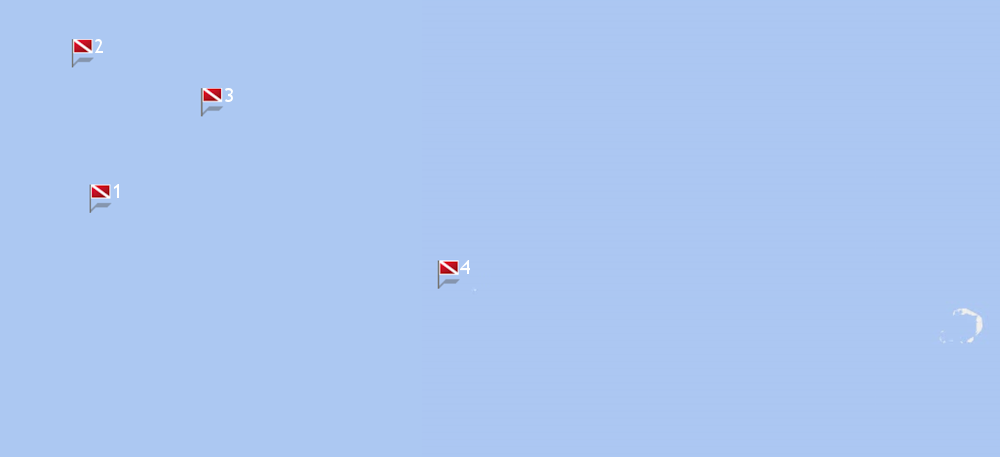|
Site Name |
Dive Type |
Difficulty |
GPS |
Max Depth |
Map |
|
1 |
Araby Maid |
Wreck |
Tech ONLY |
24°43.831 N
83°28.955 W |
205' |
|
| |
Built in Scotland in 1868, the 3 mast Araby Maid was 196 feet
long. She was then purchased by the Norwegian company M. Englestad and sunk in 1903. The vessel was traveling through the heavy shipping channels off the Dry Tortugas
when she collided with the SS Denver, creating a v-shaped gash in her portside bow causing her to sink.
Markers - None.
Details - Current is usually minimal. Remains have been significantly impacted due to Hurricane Katrina and Hurricane Wilma. Decking lumber predominantly cover
the area now, with bits and pieces of china, brass objects, broken bottles, and nautical equipment strewn through the debris.
Marine Life - Amberjack, bull sharks, permit, oysters, barracuda, goliath grouper, and sea turtles.
Recommended Certifications - Technical diving. |
|
|
|
|
2 |
M/S Rhein Hamburg |
Wreck |
Tech ONLY |
24°56.116 N
83°30.601 W |
240' |
|
| |
This transport cargo ship was built in 1926 by a German boat
company. After picking up supplies in Mexico, she was headed back to Germany. On December 11, 1940, a Dutch warship under a British flag intercepted the Rhein. The crew
knew there was no way to escape so they decided to try and burn the ship. The Dutch crew responded by putting out the fire and capturing the German crew after a short but
bloody battle. Another British ship in the area fired on the Rhein sinking her.
Markers - None.
Details - Rhein Wreck is now severely broken, deteriorated, and folded onto itself. Water is exceptionally clear, marine life is abundant.
Marine Life - Grouper and goliath grouper, snapper, shark, coral, barracuda, dolphin, sea turtles, rays.
Recommended Certifications - Technical diving. |
|
|
|
|
3 |
 |
Wreck |
Tech ONLY |
24°52.015 N
83°18.594 W |
214' |
|
| |
Commissioned October 12, 1944, this German U-boat was the
most advanced U-boat to date. With a length of 252 feet, she could stay submerged for 11 days and had a surface speed of 15 knots. Equipped with 6 bow torpedo tubes
and 23 torpedoes, she had a hydraulic loader capable of loading tubes in less than 12 minutes. She was under the command of Hans Bungards, who was relieved April
27, 1945. Her new commander, Erich Topp, held his position for less than 2 weeks before surrendering the U-boat in May, 1945 at Horten, Norway. After the US took
possession and studied it in detail, the U-boat was used for target practice. The USS Robert A. Owens (DD-827) sank the U-boat on October 7, 1951 during a rocket
test.
Markers - None.
Details - Her hull is heavily encrusted. Considerable damage to the exterior is obvious with holes ripped into the hull. In certain areas penetration is possible,
but caution must be exercised. The submarine has a 60 degree list to starboard.
Marine Life - Shark, dolphin, goliath grouper, rays, barracuda.
Recommended Certifications - Technical diving. |
|
|
|
|
4 |
Windjammer |
Wreck |
Novice |
24°37.413 N
82°56.548 W |
21' |
|
| |
Originally named the Killean, this iron hulled, 3 mast ship was built
in 1875 in England. After several changes of ownership, the ship was renamed Avanti when she was purchased by a Norwegian company. The Avanti had been in port in
Pensacola preparing to take on a load of lumber when she, and a number of other vessels were damaged by a late season Florida hurricane on October 28, 1906. After being
refurbished, she left port and headed for Uruguay. Caught by another storm on January 22, 1907, she sank after colliding with a reef.
Markers - Mooring buoys.
Details - Site is divided into 2 debris fields and is in quality condition. Vivid displays of stony and gorgonian coral, along with colorful tropical fish
permeate the wreck site.
Marine Life - Grouper, including goliath and black snapper, barracuda, shark, stony and gorgonian coral including brain coral, spiny lobster, tropical fish
including angelfish, sergeant majors, blue tang, wrasses.
Recommended Certifications - Open Water, Advanced Open Water, Enriched Air (Nitrox), Boat, Drift, Peak Performance Buoyancy, Wreck, Coral Reef Conservation. |
|
|
|
|
|
|
|
|
Reef and Fish Cards |
| Since there are thousands of different species of fish and coral, these ID cards will help you identify what you see under the ocean. |
|
|
|
|
|
|
|
|
|
|
|
|

